Host–Microbiota–Parasite Interactions in Grass Carp: Insights from Ichthyophthirius multifiliis Infection
Abstract
:1. Introduction
2. Materials and Methods
2.1. Infection Experiment
2.1.1. Infection of Parasites
Parasite-Free Grass Carp
Parasitic Infection in Grass Carp
Experimental Fish Grouping
2.2. Sample Collection
2.3. Biochemical Analysis
2.4. Histopathological Analysis
2.5. Microbiota Analysis
2.5.1. DNA Extraction
2.5.2. PCR Amplification
2.5.3. Bioinformatics Analysis
2.6. Expression Analysis of Selected Immune-Related Genes
2.7. Statistical Analysis
3. Results
3.1. Pathogen Detection Demonstrated That I. multifiliis Successfully Infected Grass Carp, Followed by Secondary Bacteria Invasion
3.2. Histopathology Suggested That the Trophonts of I. multifiliis Could Be Embedded in Epithelial Cells of Infected Fish Gills and Skin
3.3. Serum Biochemical Changes Indicated That I. multifiliis Infection Significantly Induced Hepatic and Renal Injury in Grass Carp
3.4. Alterations of the Microbiota in Skin, Gills, and Intestine Indicated I. multifiliis Infection Increased the Abundance of Opportunistic Pathogen Bacteria
3.4.1. NMDS Analysis
3.4.2. Alpha Diversity of Microbiota
Skin
Gill
Intestine
3.4.3. Skin Microbiota Diversity Reduced from ASV Distribution Venn Diagram Analysis
3.4.4. Microbiota Composition Influenced by I. multifiliis Infection
At the Phylum Level
At the Genus Level
3.5. Functional Prediction of Skin, Gill, and Intestinal Microbiota After I. multifiliis Infection of Grass Carp
3.6. qRT-PCR Assays Indicated Expression of Mucosal Immune Marker Genes IgT and TNF-α Up-Regulated While Systemic IgM Fluctuated with Increasing Tendency After Infection
3.7. Microbiota Were Correlated with Biochemical and Immune Indicators
4. Discussion
4.1. Pathological and Biochemical Changes
4.2. Gene Expression Levels of IgT, IgM, and TNF-α
4.3. Impact on Gill, Skin, and Intestinal Microbial Communities
4.3.1. Microbial Diversity
4.3.2. Phylum and Genus Abundance
4.4. Potential Microbial-Based Ciliate Parasitic Disease Management
5. Conclusions
Author Contributions
Funding
Institutional Review Board Statement
Informed Consent Statement
Data Availability Statement
Acknowledgments
Conflicts of Interest
References
- Rohani, M.F. Pesticides Toxicity in Fish: Histopathological and Hemato-Biochemical Aspects—A Review. Emerg. Contam. 2023, 9, 100234. [Google Scholar] [CrossRef]
- Peachey, L.E.; Jenkins, T.P.; Cantacessi, C. This Gut Ain’t Big Enough for Both of Us. Or Is It? Helminth–Microbiota Interactions in Veterinary Species. Trends Parasitol. 2017, 33, 619–632. [Google Scholar] [CrossRef] [PubMed]
- Cortés, A.; Peachey, L.; Scotti, R.; Jenkins, T.P.; Cantacessi, C. Helminth-Microbiota Cross-Talk—A Journey through the Verte brate Digestive System. Mol. Biochem. Parasitol. 2019, 233, 111222. [Google Scholar] [CrossRef] [PubMed]
- Zhang, X.; Ding, L.; Yu, Y.; Kong, W.; Yin, Y.; Huang, Z.; Zhang, X.; Xu, Z. The Change of Teleost Skin Commensal Microbiota Is Associated With Skin Mucosal Transcriptomic Responses During Parasitic Infection by Ichthyophthirius multifillis. Front. Immunol. 2018, 9, 2972. [Google Scholar] [CrossRef]
- Paz, E.A.; Chua, E.G.; Hassan, S.U.; Greeff, J.C.; Palmer, D.G.; Liu, S.; Lamichhane, B.; Sepúlveda, N.; Liu, J.; Tay, C.Y.; et al. Bacterial Communities in the Gastrointestinal Tract Segments of Helminth-Resistant and Helminth-Susceptible Sheep. Anim. Microbiome 2022, 4, 23. [Google Scholar] [CrossRef]
- Holm, J.B.; Sorobetea, D.; Kiilerich, P.; Ramayo-Caldas, Y.; Estellé, J.; Ma, T.; Madsen, L.; Kristiansen, K.; Svensson-Frej, M. Chronic Trichuris muris Infection Decreases Diversity of the Intestinal Microbiota and Concomitantly Increases the Abundance of Lactobacilli. PLoS ONE 2015, 10, e0125495. [Google Scholar] [CrossRef]
- Misra, P.; Singh, S. Site Specific Microbiome of Leishmania Parasite and Its Cross-Talk with Immune Milieu. Immunol. Lett. 2019, 216, 79–88. [Google Scholar] [CrossRef]
- Mrázek, J.; Mrázková, L.; Mekadim, C.; Jarošíková, T.; Krayem, I.; Sohrabi, Y.; Demant, P.; Lipoldová, M. Effects of Leishmania Major Infection on the Gut Microbiome of Resistant and Susceptible Mice. Appl. Microbiol. Biotechnol. 2024, 108, 145. [Google Scholar] [CrossRef]
- Fu, P.P.; Xiong, F.; Feng, W.W.; Zou, H.; Wu, S.G.; Li, M.; Wang, G.T.; Li, W.X. Effect of Intestinal Tapeworms on the Gut Microbiota of the Common Carp, Cyprinus carpio. Parasit. Vectors 2019, 12, 252. [Google Scholar] [CrossRef]
- Gaulke, C.A.; Martins, M.L.; Watral, V.G.; Humphreys, I.R.; Spagnoli, S.T.; Kent, M.L.; Sharpton, T.J. A Longitudinal Assess ment of Host-Microbe-Parasite Interactions Resolves the Zebrafish Gut Microbiome’s Link to Pseudocapillaria tomentosa Infection and Pathology. Microbiome 2019, 7, 10. [Google Scholar] [CrossRef]
- Ling, F.; Steinel, N.; Weber, J.; Ma, L.; Smith, C.; Correa, D.; Zhu, B.; Bolnick, D.; Wang, G. The Gut Microbiota Response to Helminth Infection Depends on Host Sex and Genotype. ISME J. 2020, 14, 1141–1153. [Google Scholar] [CrossRef] [PubMed]
- Fu, P.P.; Xiong, F.; Wu, S.G.; Zou, H.; Li, M.; Wang, G.T.; Li, W.X. Effects of Schyzocotyle acheilognathi (Yamaguti, 1934) Infection on the Intestinal Microbiota, Growth and Immune Reactions of Grass Carp (Ctenopharyngodon idella). PLoS ONE 2022, 17, e0266766. [Google Scholar] [CrossRef] [PubMed]
- Vasemägi, A.; Visse, M.; Kisand, V. Effect of Environmental Factors and an Emerging Parasitic Disease on Gut Microbiome of Wild Salmonid Fish. mSphere 2017, 2, e00418-17. [Google Scholar] [CrossRef] [PubMed]
- Wang, L.; Zhang, D.; Xie, J.; Chang, O.; Wang, Q.; Shi, C.; Zhao, F.; Gong, H.; Ren, Y.; Musa, N.; et al. Do Ectoparasites on Fish Gills “Talk” with Gut Microbiota Far Away? Aquaculture 2023, 562, 738880. [Google Scholar] [CrossRef]
- Wu, S.; Wang, G.; Angert, E.R.; Wang, W.; Li, W.; Zou, H. Composition, Diversity, and Origin of the Bacterial Community in Grass Carp Intestine. PLoS ONE 2012, 7, e30440. [Google Scholar] [CrossRef]
- Tran, N.T.; Wang, G.-T.; Wu, S.-G. A Review of Intestinal Microbes in Grass Carp Ctenopharyngodon idellus (Valenciennes). Aquac. Res. 2017, 48, 3287–3297. [Google Scholar] [CrossRef]
- Yu, H. Histopathological Study of Grass Carp (Ctenopharyngodon idella) Experimentally Infected with Ichthyophthirius multifiliis. Afr. J. Microbiol. Res. 2012, 6, 3539–3544. [Google Scholar] [CrossRef]
- Yang, H.; Tu, X.; Xiao, J.; Hu, J.; Gu, Z. Investigations on White Spot Disease Reveal High Genetic Diversity of the Fish Parasite, Ichthyophthirius multifiliis (Fouquet, 1876) in China. Aquaculture 2023, 562, 738804. [Google Scholar] [CrossRef]
- Guo, S.Q.; Fu, Y.W.; Hou, T.L.; Huang, S.L.; Zhang, Q.Z. Establishment and Application of TaqMan Probe-based Quantitative Real-time PCR for Rapid Detection and Quantification of Ichthyophthirius multifiliis in Farming Environments and Fish Tissues. Vet. Parasitol. 2025, 334, 110381. [Google Scholar] [CrossRef]
- Dickerson, H.; Clark, T. Ichthyophthirius multifiliis: A Model of Cutaneous Infection and Immunity in Fishes. Immunol. Rev. 1998, 166, 377–384. [Google Scholar] [CrossRef]
- Huang, K.; Hu, G.; Wang, R.; Zeng, Q.; Li, W.; Zou, H.; Wu, S.; Wang, G.; Li, M. In Vitro Assessment of Berberine against Ichthyophthirius multifiliis in Goldfish. Pathogens 2022, 11, 1207. [Google Scholar] [CrossRef] [PubMed]
- Von Gersdorff Jørgensen, L.; Heinecke, R.D.; Skjødt, K.; Rasmussen, K.J.; Buchmann, K. Experimental Evidence for Direct in Situ Binding of IgM and IgT to Early Trophonts of Ichthyophthirius multifiliis (Fouquet) in the Gills of Rainbow Trout, Oncorhynchus mykiss (Walbaum). J. Fish Dis. 2011, 34, 749–755. [Google Scholar] [CrossRef] [PubMed]
- Akbari, M.; Taghizadeh, V.; Heidarieh, M.; Hajimoradloo, A. The Key Role of Tumor Necrosis Factor Alpha (TNF-α) in Vac cinated Rainbow Trout via Irradiated Ichthyophthirius multifiliis Trophont. Vet. Arh. 2017, 87, 229–237. [Google Scholar]
- Yu, H.; Yan, Q.G.; Wang, Z.B.; Lu, Y.J.; Xu, M.J.; Li, H.; Zhu, X.Q. MH II—DAB Gene Expression in Grass Carp Ctenopharyngodon idella (Valenciennes) after Infection with the Ciliate Parasite, Ichthyophthirius multifiliis. J. Fish Dis. 2014, 37, 43–50. [Google Scholar] [CrossRef]
- Zhao, F.; Li, Y.-W.; Pan, H.-J.; Shi, C.-B.; Luo, X.-C.; Li, A.-X.; Wu, S.-Q. TAK1-Binding Proteins (TAB1 and TAB2) in Grass Carp (Ctenopharyngodon idella): Identification, Characterization, and Expression Analysis after Infection with Ichthyophthirius multifiliis. Fish Shellfish Immunol. 2014, 38, 389–399. [Google Scholar] [CrossRef]
- Shen, M.; Jiang, Z.; Zhang, K.; Li, C.; Liu, F.; Hu, Y.; Zheng, S.; Zheng, R. Transcriptome Analysis of Grass Carp (Ctenopharyngodon idella) and Holland’s Spinibarbel (Spinibarbus hollandi) Infected with Ichthyophthirius multifiliis. Fish Shellfish Immunol. 2022, 121, 305–315. [Google Scholar] [CrossRef]
- Lu, Z.; Gao, R.; Duan, Y.; Han, R.; Guo, W.; Dan, X.; Li, Y. Isolation and Genetic Characterization of Flavobacterium columnare from Grass Carp, Ctenopharyngodon idellus, in China. Aquaculture 2021, 541, 736762. [Google Scholar] [CrossRef]
- Samayanpaulraj, V.; Sivaramapillai, M.; Palani, S.N.; Govindaraj, K.; Velu, V.; Ramesh, U. Identification and Characterization of Virulent Aeromonas hydrophila Ah17 from Infected Channa striata in River Cauvery and in Vitro Evaluation of Shrimp Chitosan. Food Sci. Nutr. 2020, 8, 1272–1283. [Google Scholar] [CrossRef]
- Xu, D.; Klesius, P. Two Year Study on the Infectivity of Ichthyophthirius multifiliis in Channel Catfish Ictalurus punctatus. Dis. Aquat. Organ. 2004, 59, 131–134. [Google Scholar] [CrossRef]
- Ramos, M.; Costa, A.; Barandela, T.; Saraiva, A.; Rodrigues, P. Scuticociliate Infection and Pathology in Cultured Turbot Scophthalmus maximus from the North of Portugal. Dis. Aquat. Organ. 2007, 74, 249–253. [Google Scholar] [CrossRef]
- González Raya, A.; Coca Zúñiga, R.; Martín Salido, E. Isolated Elevation of Aspartate Aminotransferase (AST) in an Asymp tomatic Patient Due to macro-AST. J. Clin. Lab. Anal. 2019, 33, e22690. [Google Scholar] [CrossRef] [PubMed]
- Crudele, L.; De Matteis, C.; Piccinin, E.; Gadaleta, R.M.; Cariello, M.; Di Buduo, E.; Piazzolla, G.; Suppressa, P.; Berardi, E.; Sabbà, C.; et al. Low HDL-Cholesterol Levels Predict Hepatocellular Carcinoma Development in Individuals with Liver Fibrosis. JHEP Rep. 2023, 5, 100627. [Google Scholar] [CrossRef] [PubMed]
- Loomba, R. Serum Alanine Aminotransferase as a Biomarker of Treatment Response in Nonalcoholic Steatohepatitis. Clin. Gastroenterol. Hepatol. 2014, 12, 1731–1732. [Google Scholar] [CrossRef] [PubMed]
- Christou-Savina, S.; Beales, P.L.; Osborn, D.P.S. Evaluation of Zebrafish Kidney Function Using a Fluorescent Clearance Assay. J. Vis. Exp. 2015, 96, 52540. [Google Scholar] [CrossRef]
- Tyagi, R. Chronic Effect Due to Changes in the Contents of Urea & Creatinine in Edible Cat Fish Channa Punctatus (Bloch), Under the Stress of Sub Lethal Concentration of Methyl Parathion - a pesticide. Environ. Conserv. J. 2011, 12, 89–92. [Google Scholar] [CrossRef]
- Behrens, J.W.; Ryberg, M.P.; Chondromatidou, V.; Iburg, T.M. Comparative Histopathology of Livers from Baltic Cod Infected with the Parasitic Nematode Contracaecum osculatum. J. Fish Dis. 2023, 46, 653–662. [Google Scholar] [CrossRef]
- Stumbo, A.D.; Goater, C.P.; Hontela, A. Parasite-Induced Oxidative Stress in Liver Tissue of Fathead Minnows Exposed to Trematode Cercariae. Parasitology 2012, 139, 1666–1671. [Google Scholar] [CrossRef]
- Rastiannasab, A.; Afsharmanesh, S.; Rahimi, R.; Sharifian, I. Alternations in the Liver Enzymatic Activity of Common carp, Cyprinus carpio in Response to Parasites, Dactylogyrus spp. and Gyrodactylus spp. J. Parasit. Dis. 2016, 40, 1146–1149. [Google Scholar] [CrossRef]
- Yu, Y.-Y.; Kong, W.; Yin, Y.-X.; Dong, F.; Huang, Z.-Y.; Yin, G.-M.; Dong, S.; Salinas, I.; Zhang, Y.-A.; Xu, Z. Mucosal Immuno globulins Protect the Olfactory Organ of Teleost Fish against Parasitic Infection. PLoS Pathog. 2018, 14, e1007251. [Google Scholar] [CrossRef]
- Kong, W.; Yu, Y.; Dong, S.; Huang, Z.; Ding, L.; Cao, J.; Dong, F.; Zhang, X.; Liu, X.; Xu, H.; et al. Pharyngeal Immunity in Early Vertebrates Provides Functional and Evolutionary Insight into Mucosal Homeostasis. J. Immunol. 2019, 203, 3054–3067. [Google Scholar] [CrossRef]
- Xu, J.; Yu, Y.; Huang, Z.; Dong, S.; Luo, Y.; Yu, W.; Yin, Y.; Li, H.; Liu, Y.; Zhou, X.; et al. Immunoglobulin (Ig) Heavy Chain Gene Locus and Immune Responses upon Parasitic, Bacterial and Fungal Infection in Loach, Misgurnus anguillicaudatus. Fish Shellfish Immunol. 2019, 86, 1139–1150. [Google Scholar] [CrossRef] [PubMed]
- Zhi, T.; Huang, C.; Sun, R.; Zheng, Y.; Chen, J.; Xu, X.; Brown, C.L.; Yang, T. Mucosal Immune Response of Nile Tilapia Oreochromis niloticus during Gyrodactylus cichlidarum Infection. Fish Shellfish Immunol. 2020, 106, 21–27. [Google Scholar] [CrossRef] [PubMed]
- Keyt, B.A.; Baliga, R.; Sinclair, A.M.; Carroll, S.F.; Peterson, M.S. Structure, Function, and Therapeutic Use of IgM Antibodies. Antibodies 2020, 9, 53. [Google Scholar] [CrossRef] [PubMed]
- Syahputra, K.; Kania, P.W.; Al-Jubury, A.; Marnis, H.; Setyawan, A.C.; Buchmann, K. Differential Immune Gene Response in Gills, Skin, and Spleen of Rainbow Trout Oncorhynchus mykiss Infected by Ichthyophthirius multifiliis. PLoS ONE 2019, 14, e0218630. [Google Scholar] [CrossRef]
- Xu, D.-H.; Moreira, G.S.A.; Shoemaker, C.A.; Zhang, D.; Beck, B.H. Expression of Immune Genes in Systemic and Mucosal Immune Tissues of Channel Catfish Vaccinated with Live Theronts of Ichthyophthirius multifiliis. Fish Shellfish Immunol. 2017, 66, 540–547. [Google Scholar] [CrossRef]
- Paul, A.; Mohanty, J.; Rajendran, K.V.; Tripathi, G.; Sahoo, P.K. First Report of Dactylogyrus scorpius Infection in Indian Major Carp, Labeo rohita from India: Host Specificity and Kinetics of Immune Gene Expression in Gills. Aquaculture 2021, 536, 736453. [Google Scholar] [CrossRef]
- Tu, X.; Qi, X.; Huang, A.; Ling, F.; Wang, G. Cytokine Gene Expression Profiles in Goldfish (Carassius auratus) during Gyrodactylus kobayashii Infection. Fish Shellfish Immunol. 2019, 86, 116–124. [Google Scholar] [CrossRef]
- Shater, A.F.; AlGabbani, Q.; Mohammedsaleh, Z.M.; Saleh, F.M.; AbouLaila, M.; Noreldin, A.E.; Raza, S.H.A.; Ullah, H.; Khan, R.; Menshawy, S. Expression of Immune-Related Genes in Parasite-Infected Tilapia Nilotica (Oreochromis niloticus) from Egypt and Molecular Characterization of the Parasites. Gene Rep. 2022, 26, 101451. [Google Scholar] [CrossRef]
- Llewellyn, M.S.; Leadbeater, S.; Garcia, C.; Sylvain, F.-E.; Custodio, M.; Ang, K.P.; Powell, F.; Carvalho, G.R.; Creer, S.; Elliot, J.; et al. Parasitism Perturbs the Mucosal Microbiome of Atlantic Salmon. Sci. Rep. 2017, 7, 43465. [Google Scholar] [CrossRef]
- Morris, T.C.; Van Der Ploeg, J.; Bih Awa, S.; Van Der Lingen, C.D.; Reed, C.C. Parasite Community Structure as a Predictor of Host Population Structure: An Example Using Callorhinchus capensis. Int. J. Parasitol. Parasites Wildl. 2019, 8, 248–255. [Google Scholar] [CrossRef]
- Hsu, P.; Pan, C.; Kao, J.Y.; Tsay, F.; Peng, N.; Kao, S.; Wang, H.; Tsai, T.; Wu, D.; Chen, C.; et al. Helicobacter pylori Eradication with Bismuth Quadruple Therapy Leads to Dysbiosis of Gut Microbiota with an Increased Relative Abundance of Proteobacteria and Decreased Relative Abundances of Bacteroidetes and Actinobacteria. Helicobacter 2018, 23, e12498. [Google Scholar] [CrossRef] [PubMed]
- Petersen, A.M.; Mirsepasi-Lauridsen, H.C.; Vester-Andersen, M.K.; Sørensen, N.; Krogfelt, K.A.; Bendtsen, F. High Abundance of Proteobacteria in Ileo-Anal Pouch Anastomosis and Increased Abundance of Fusobacteria Associated with Increased Pouch Inflammation. Antibiotics 2020, 9, 237. [Google Scholar] [CrossRef] [PubMed]
- Vester-Andersen, M.K.; Mirsepasi-Lauridsen, H.C.; Prosberg, M.V.; Mortensen, C.O.; Träger, C.; Skovsen, K.; Thorkilgaard, T.; Nøjgaard, C.; Vind, I.; Krogfelt, K.A.; et al. Increased Abundance of Proteobacteria in Aggressive Crohn’s Disease Seven Years after Diagnosis. Sci. Rep. 2019, 9, 13473. [Google Scholar] [CrossRef] [PubMed]
- Ashour, D.S.; Othman, A.A. Parasite–Bacteria Interrelationship. Parasitol. Res. 2020, 119, 3145–3164. [Google Scholar] [CrossRef]
- Molinas-Vera, M.; Ferreira-Sanabria, G.; Peña, P.; Sandoval-Espinola, W.J. The Paraguayan Gut Microbiome Contains High Abundance of the Phylum Actinobacteriota and Reveals the Influence of Health and Lifestyle Factors. Gut Microbes Rep. 2024, 1, 1–16. [Google Scholar] [CrossRef]
- Strompfová, V.; Štempelová, L. Composition and Diversity of 16S rRNA Based Skin Bacterial Microbiome in Healthy Horses. Vet. Res. Commun. 2024, 48, 2847–2855. [Google Scholar] [CrossRef]
- LaFrentz, B.R.; García, J.C.; Waldbieser, G.C.; Evenhuis, J.P.; Loch, T.P.; Liles, M.R.; Wong, F.S.; Chang, S.F. Identification of Four Distinct Phylogenetic Groups in Flavobacterium columnare With Fish Host Associations. Front. Microbiol. 2018, 9, 452. [Google Scholar] [CrossRef]
- Einarsdottir, T.; Guttormsdottir, G.; Connaghan, D.; Hjartardottir, S. Longitudinal Survey of Flavobacterium Species in Icelandic Salmonid Fish Farms. Dis. Aquat. Organ. 2020, 141, 15–24. [Google Scholar] [CrossRef]
- Busse, H.-J.; Kämpfer, P.; Szostak, M.P.; Spergser, J. Luteolibacter ambystomatis sp. Nov., Isolated from the Skin of an Ander son’s Salamander (Ambystoma andersoni). Int. J. Syst. Evol. Microbiol. 2021, 71, 005043. [Google Scholar] [CrossRef]
- Pasqualetti, C.; Szokoli, F.; Rindi, L.; Petroni, G.; Schrallhammer, M. The Obligate Symbiont “Candidatus Megaira Polyxenoph ila” Has Variable Effects on the Growth of Different Host Species. Front. Microbiol. 2020, 11, 1425. [Google Scholar] [CrossRef]
- Manchanayake, T.; Salleh, A.; Amal, M.N.A.; Yasin, I.S.M.; Zamri-Saad, M. Pathology and Pathogenesis of Vibrio Infection in Fish: A Review. Aquac. Rep. 2023, 28, 101459. [Google Scholar] [CrossRef]
- Sun, H.; Wang, L.; Chen, F.; Meng, X.; Zheng, W.; Peng, H.; Hao, H.; Chen, H.; Wang, K.-J. The Modulation of Intestinal Commensal Bacteria Possibly Contributes to the Growth and Immunity Promotion in Epinephelus Akaara after Feeding the Antimicrobial Peptide Scy-Hepc. Anim. Microbiome 2024, 6, 54. [Google Scholar] [CrossRef] [PubMed]
- Yi, M.; Sheng, Q.; Lv, Z.; Lu, H. Novel Pathway and Acetate-Facilitated Complete Atenolol Degradation by Hydrogenophaga sp. YM1 Isolated from Activated Sludge. Sci. Total Environ. 2022, 810, 152218. [Google Scholar] [CrossRef] [PubMed]
- Lin, S.-Y.; Hameed, A.; Wen, C.-Z.; Hsu, Y.-H.; Liu, Y.-C.; Lai, W.-A.; Young, C.-C. Hydrogenophaga aquatica sp. Nov., Isolated from a Hot Spring. Int. J. Syst. Evol. Microbiol. 2017, 67, 3716–3721. [Google Scholar] [CrossRef]
- Sgroi, G.; Iatta, R.; Lovreglio, P.; Stufano, A.; Laidoudi, Y.; Mendoza-Roldan, J.A.; Bezerra-Santos, M.A.; Veneziano, V.; Di Gennaro, F.; Saracino, A.; et al. Detection of Endosymbiont Candidatus Midichloria Mitochondrii and Tickborne Pathogens in Humans Exposed to Tick Bites, Italy. Emerg. Infect. Dis. 2022, 28, 1824–1832. [Google Scholar] [CrossRef]
- Giannotti, D.; Boscaro, V.; Husnik, F.; Vannini, C.; Keeling, P.J. The “Other” Rickettsiales: An Overview of the Family “Candidatus Midichloriaceae”. Appl. Environ. Microbiol. 2022, 88, e02432-21. [Google Scholar] [CrossRef]
- Zhang, B.; Yang, H.; Cai, G.; Nie, Q.; Sun, Y. The interactions between the host immunity and intestinal microorganisms in fish. Appl. Microbiol. Biotechnol. 2024, 108, 30. [Google Scholar] [CrossRef]
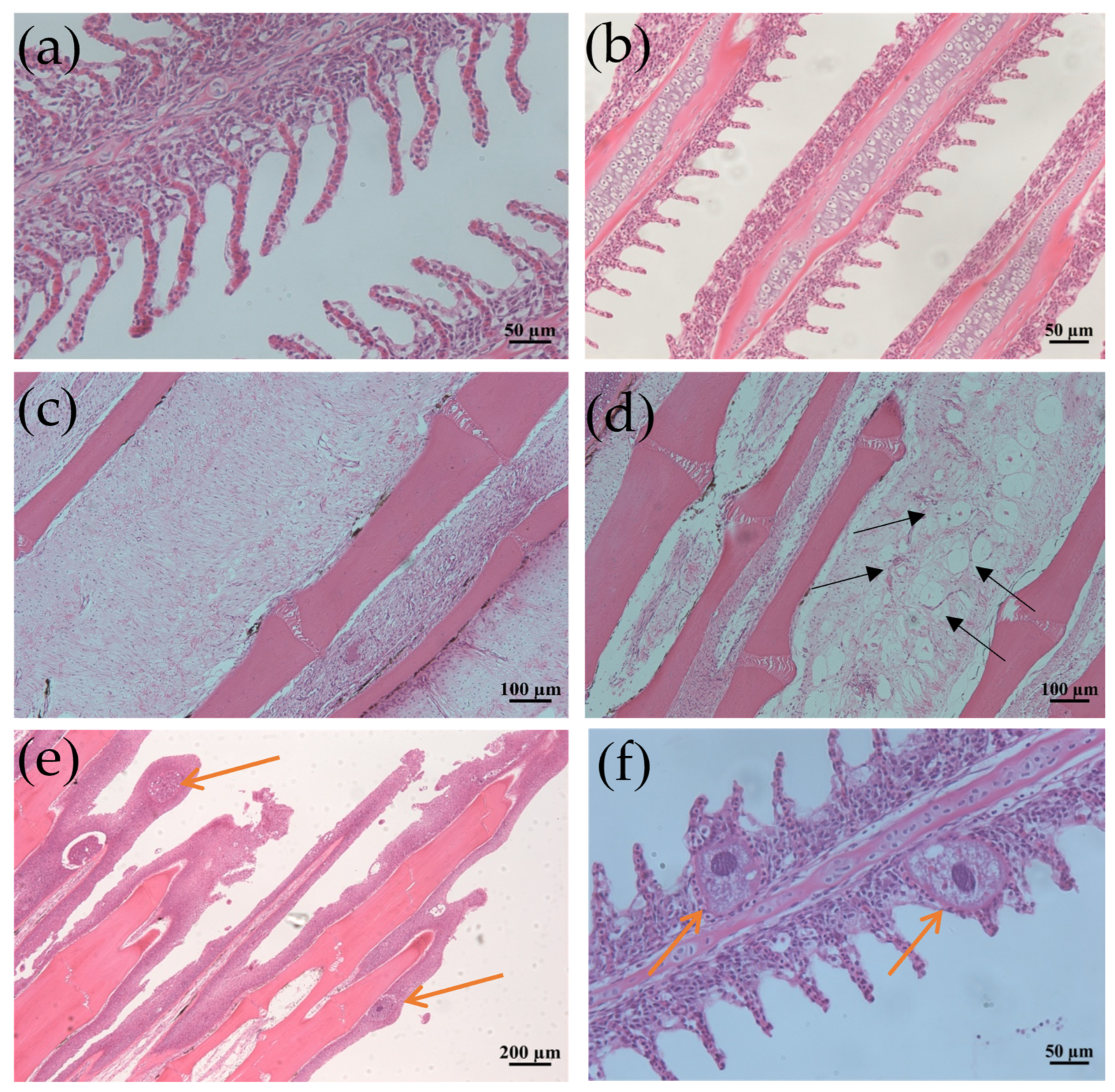

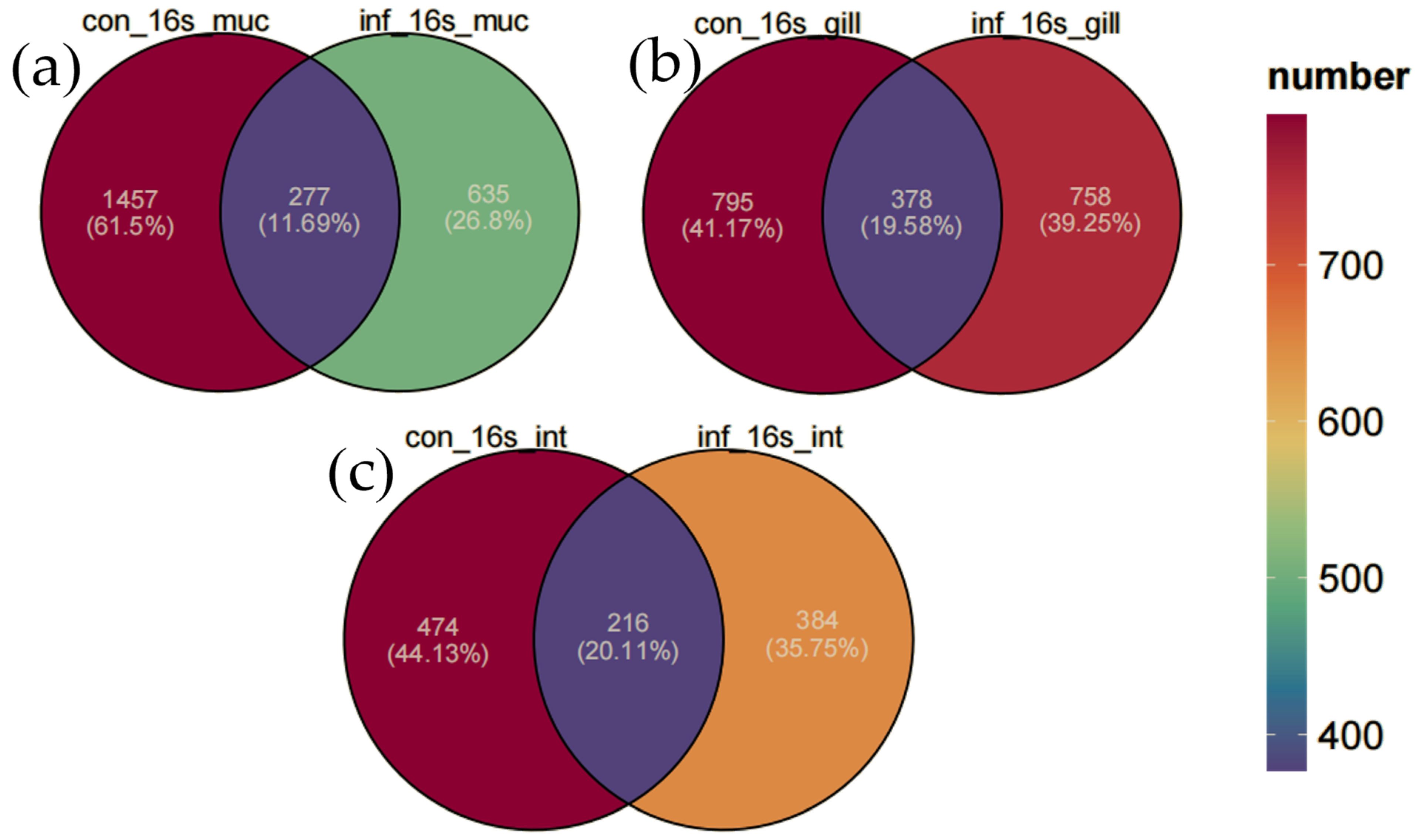

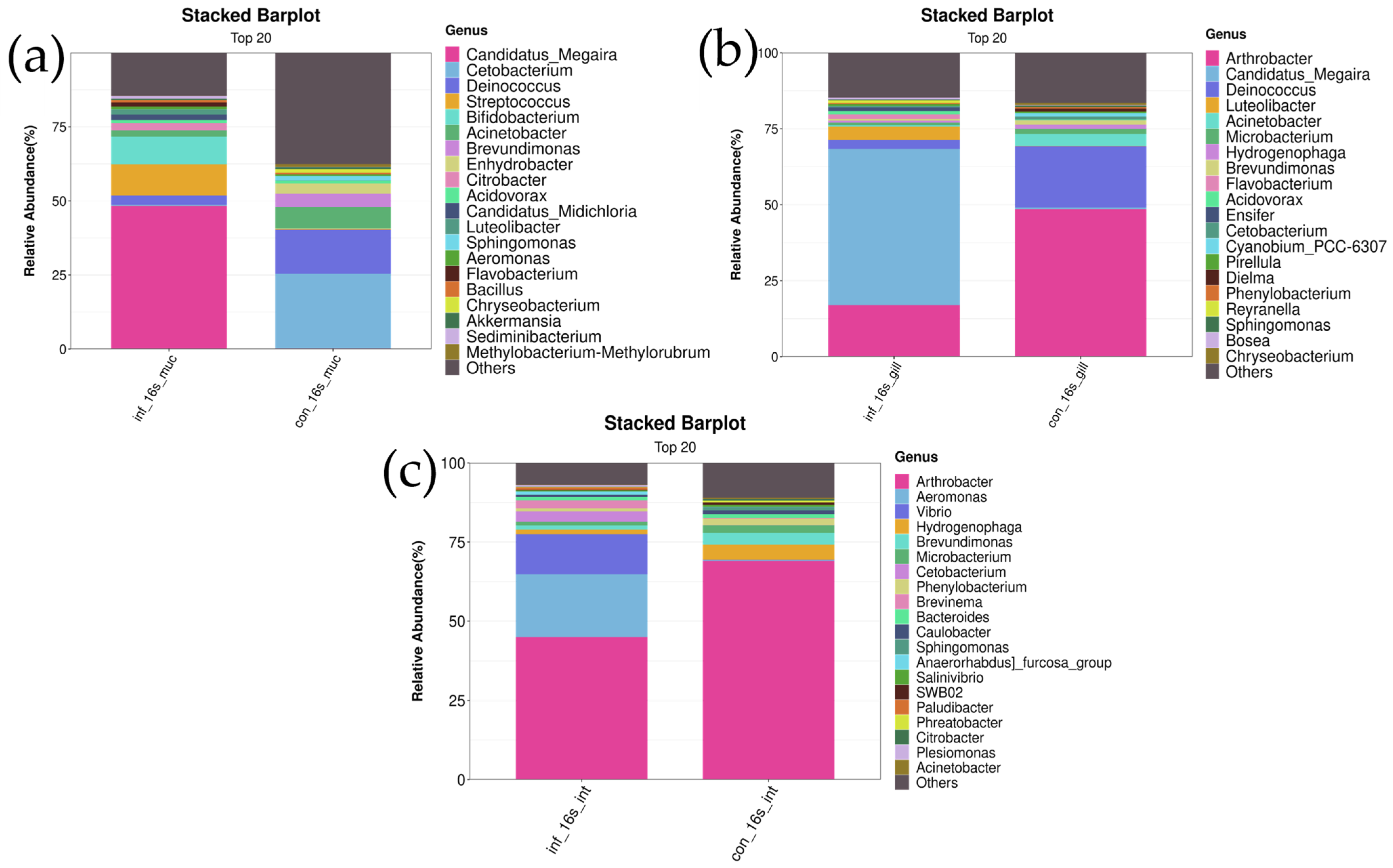


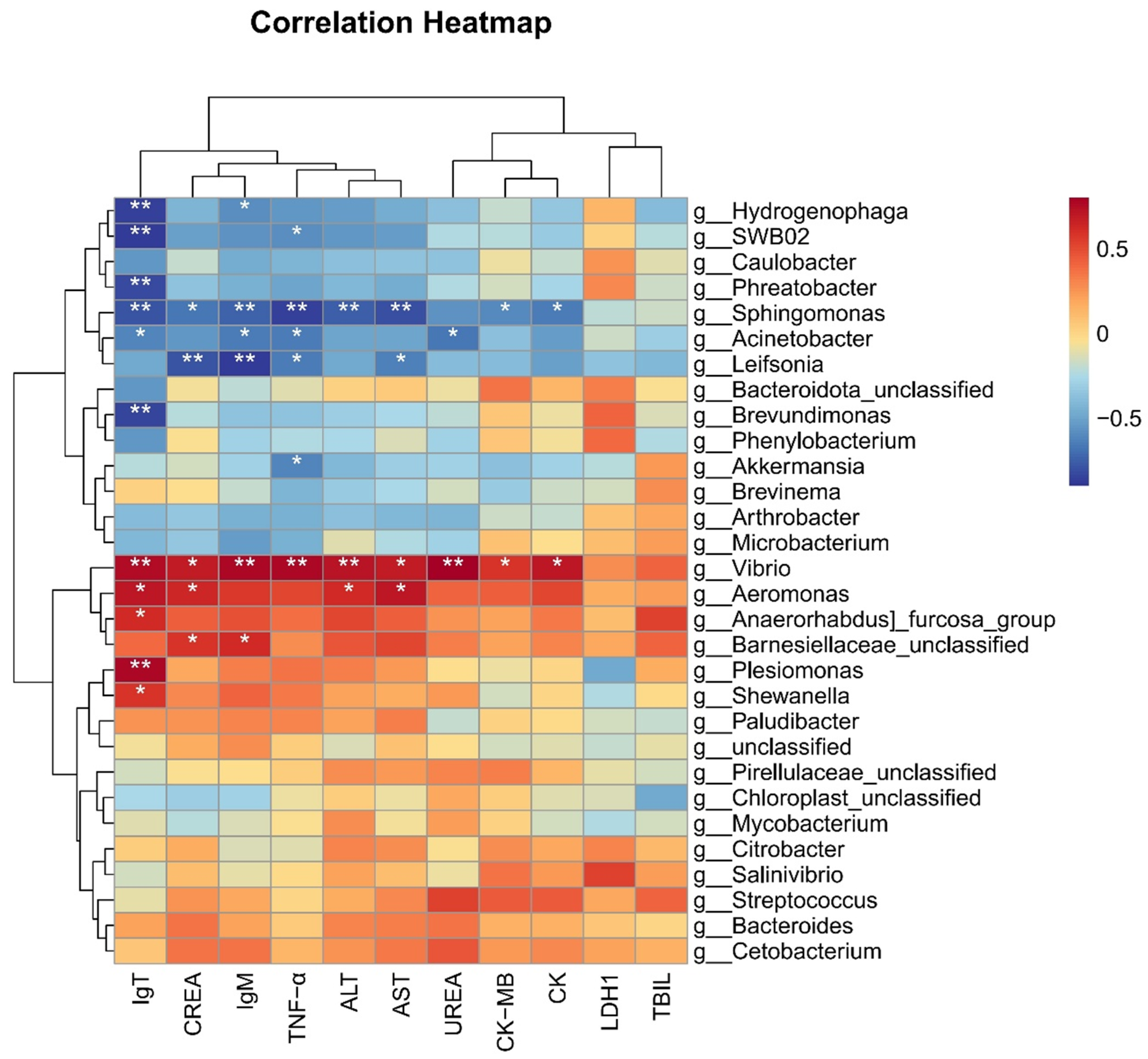
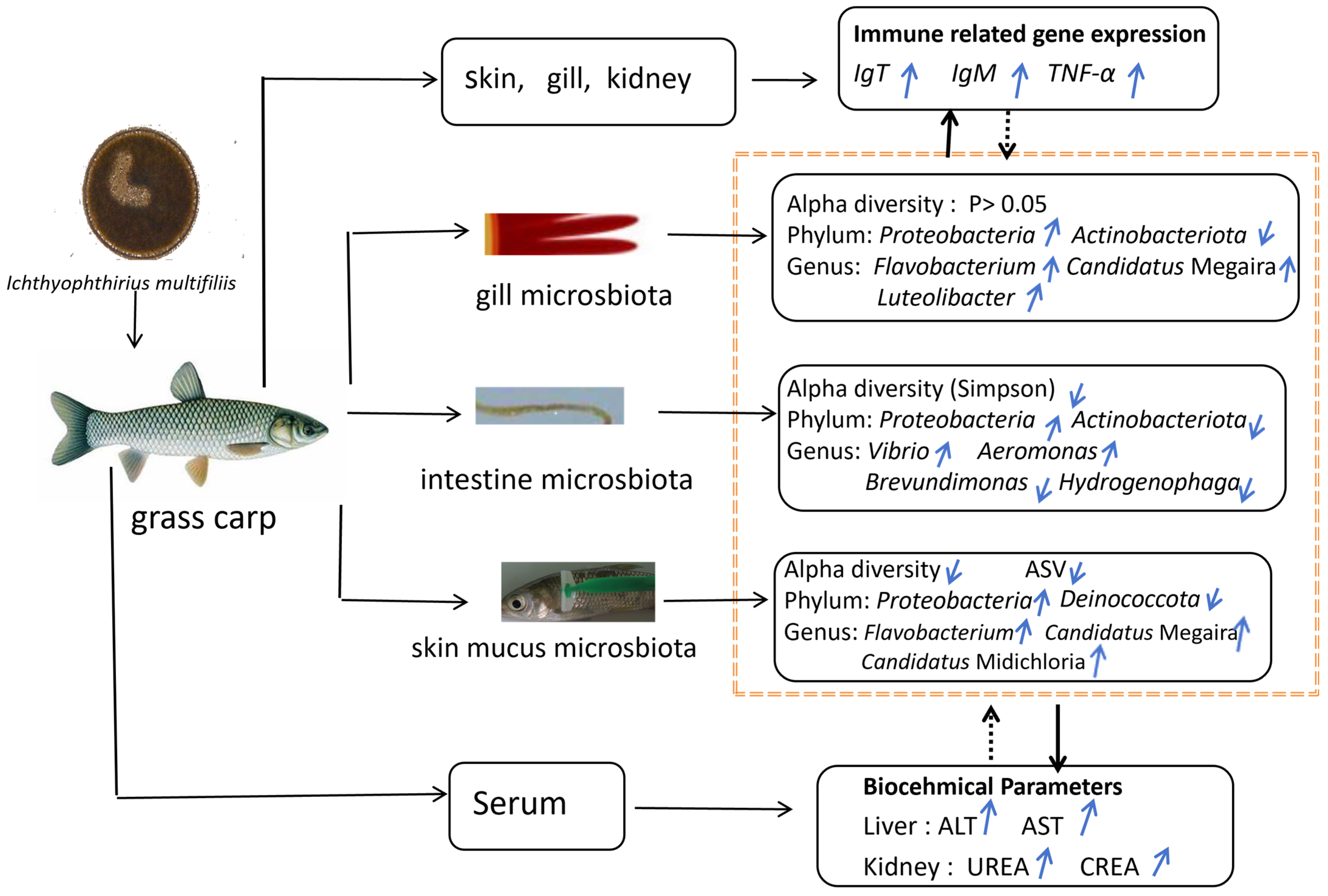
| Primer Name | Sequence (5′–3′) | GenBank Accession No. |
|---|---|---|
| β-actin | F: 5′-GGATGATGAAATTGCCGCACTGG-3′ | M25013 |
| R: 5′-ACCGACCATGACGCCCTGATGT-3′ | ||
| IgT | F:5′-AGGAGGAGGTCTGGAGTG-3′ | GQ201419.1 |
| R:5′-GAAAGCCCAGTTGTAGTT-3′ | ||
| TNF-α | F: 5′-TGTGCCGCCGCTGTCTGCTTCACGCT-3′ | NC067238 |
| R: 5′-GATGAGGAAAGACACCTGGCTGTAGA-3′ | ||
| IgM | F:5′-TCTACCTCCAACTCCACCACC-3′ | DQ417927 |
| R:5′-TGTTTATTGTATTTGCCACCTGAT-3′ |
| Pathogen | Uninfected Group | Infected Group |
|---|---|---|
| I. multifiliis | − | +++ |
| GCRV | − | − |
| Flavobacterium | − | + |
| Aeromonas | − | + |
| Vibrio | − | − |
| Parameters | Uninfected Group | Infected Group |
|---|---|---|
| ALT (U/L) | 4.25 ± 2.40 | 12.20 ± 6.89 * |
| AST (U/L) | 60.95 ± 18.50 | 234.65 ± 151.22 * |
| TBIL (μmol/L) | 7.63 ± 1.30 | 11.63 ± 6.60 |
| UREA (mmol/L) | 0.54 ± 0.24 | 1.01 ± 0.37 * |
| CREA (μmol/L) | 19.34 ± 3.86 | 35.06 ± 14.52 * |
| CK (U/L) | 3148.58 ± 1411.64 | 6661.09 ± 4007.94 |
| CK-MB (U/L) | 2562.24 ± 1118.26 | 4988.95 ± 2963.95 |
| LDH1 (U/L) | 141.22 ± 56.47 | 165.72 ± 88.19 |
| Groups | Tissue | Observed Species | Shannon | Simpson | Chao1 | Goods Coverage |
|---|---|---|---|---|---|---|
| Control | Skin | 452.00 ± 10.12 | 5.38 ± 0.33 | 0.86 ± 0.05 | 455.19 ± 15.45 | 1 |
| Intestine | 177.33 ± 12.45 | 2.88 ± 0.45 | 0.65 ± 0.04 | 177.68 ± 13.65 | 1 | |
| Gill | 341.00 ± 10.12 | 3.93 ± 0.33 | 0.70 ± 0.05 | 341.02 ± 15.45 | 1 | |
| Infection | Skin | 280.17 ± 12.45 * | 3.64 ± 0.45 * | 0.73 ± 0.04 | 281.92 ± 13.65 * | 1 |
| Intestine | 172.50 ± 10.12 | 2.57 ± 0.33 | 0.52 ± 0.05 * | 173.04 ± 15.45 | 1 | |
| Gill | 321.50 ± 12.45 | 3.37 ± 0.45 | 0.68 ± 0.04 | 321.62 ± 13.65 | 1 |
Disclaimer/Publisher’s Note: The statements, opinions and data contained in all publications are solely those of the individual author(s) and contributor(s) and not of MDPI and/or the editor(s). MDPI and/or the editor(s) disclaim responsibility for any injury to people or property resulting from any ideas, methods, instructions or products referred to in the content. |
© 2025 by the authors. Licensee MDPI, Basel, Switzerland. This article is an open access article distributed under the terms and conditions of the Creative Commons Attribution (CC BY) license (https://creativecommons.org/licenses/by/4.0/).
Share and Cite
Li, F.; Jiang, D.; Wang, Q.; Chang, O.; Yin, J.; Yu, M.; Pan, H. Host–Microbiota–Parasite Interactions in Grass Carp: Insights from Ichthyophthirius multifiliis Infection. Microorganisms 2025, 13, 872. https://doi.org/10.3390/microorganisms13040872
Li F, Jiang D, Wang Q, Chang O, Yin J, Yu M, Pan H. Host–Microbiota–Parasite Interactions in Grass Carp: Insights from Ichthyophthirius multifiliis Infection. Microorganisms. 2025; 13(4):872. https://doi.org/10.3390/microorganisms13040872
Chicago/Turabian StyleLi, Fangxiang, Dongdong Jiang, Qing Wang, Ouqin Chang, Jiyuan Yin, Meiling Yu, and Houjun Pan. 2025. "Host–Microbiota–Parasite Interactions in Grass Carp: Insights from Ichthyophthirius multifiliis Infection" Microorganisms 13, no. 4: 872. https://doi.org/10.3390/microorganisms13040872
APA StyleLi, F., Jiang, D., Wang, Q., Chang, O., Yin, J., Yu, M., & Pan, H. (2025). Host–Microbiota–Parasite Interactions in Grass Carp: Insights from Ichthyophthirius multifiliis Infection. Microorganisms, 13(4), 872. https://doi.org/10.3390/microorganisms13040872





